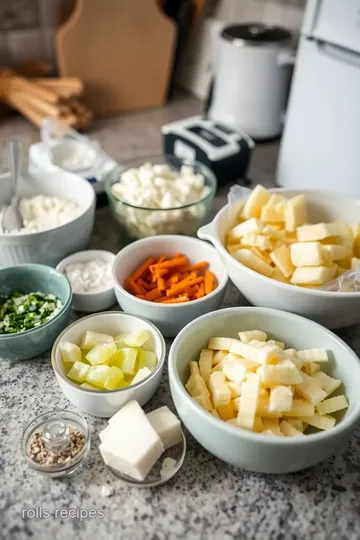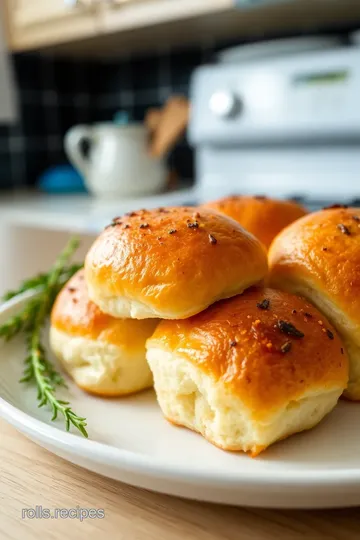Flaky Cheese Onion Rolls: A Savory Delight
Wondering how to Bake Cheese Onion Rolls with Flaky Crust that will impress? These golden rolls are a cherished family recipe you've got to try!

- A Warm Welcome to Bake Cheese Onion Rolls with Flaky Crust
- The Story Behind the Rolls: A Classic Treat
- Why You’ll Fall in Love with These Rolls
- Let’s Get to the Ingredients
- Essential Ingredients Guide
- The Art of Professional Cooking: Prepare for Flaky Cheese Onion Rolls
- Unlocking the Secrets to Savory Cheese Onion Rolls
- Recipe Card
A Warm Welcome to Bake Cheese Onion Rolls with Flaky Crust
Picture this: it’s a chilly sunday afternoon. the kind that makes you want to curl up under a blanket with something warm and cozy.
I remember making my first batch of flaky cheese onion rolls right when the leaves turned golden-brown. my kitchen filled with the warm, heavenly scent of caramelized onions mingling with melty cheese .
I mean, who doesn’t love that smell, right? it’s pure comfort in a roll!
Honestly, if you've ever had a knockout snack that instantly makes you feel like you’re home—this is it! it’s a delightful combination of buttery, flaky crust and savory cheese and onion filling.
Just thinking about biting into those soft, golden-brown rolls makes my mouth water. whether it's for game day or a cozy evening with friends, this recipe is a hit every time!
The Story Behind the Rolls: A Classic Treat
These little beauties have roots that go way back. they come from classic european baking traditions, where celebrating with savory appetizers means filling your home with love and delicious aromas.
And today, they’ve found a loving spot in kitchens across america. no longer just party food, these rolls have become a go-to for easy gatherings and potlucks.
They are like an old friend, always welcome, no matter the occasion.
Now, don’t let their fancy name fool you! making these homemade cheese rolls is surprisingly simple. sure, it requires a bit of dough handling and rolling techniques, but i promise you can ace this with basic kitchen skills.
Plus, they’re ready in a little more than an hour—about 30 minutes of prep and 20- 25 minutes of baking, plus a bit of chilling time.
It’s just enough to mix up a fun playlist while you cook!
And the best part? you can whip up around 12 rolls without breaking the bank! you probably have most of the ingredients hiding in your pantry right now—flour, butter, onions, and cheese are common staples.
Just pop out that apron and get ready for some deliciousness!
Why You’ll Fall in Love with These Rolls
Health benefits and nutrition highlights: these rolls are not just tasty; they’ve got some perks too! onions are packed with antioxidants, and they can really amp up your immune system.
Pair them with cheese, and you have a treat that’s both comforting and somewhat nutritious—if you eat in moderation, of course!
Unique selling points: what sets these apart from run-of-the-mill treats? ah, it's in the flaky pastry recipe and that buttery pastry dough ! the combination of a crispy exterior and gooey interior makes them irresistible.
Not to mention, you can mix and match your cheese combinations for baking —gruyère, cheddar, or whatever tickles your taste buds!
Perfect for special occasions, these rolls are appetizer ideas for parties that impress without the stress. serve them warm as bite-sized snacks, and watch them disappear.
They're happiness in every flaky bite, making them perfect for gatherings, family dinners, or even just a snack when you're craving something indulgent.
And for those of you needing a twist, try adding fresh herbs or experimenting with other fillings. you can even offer gluten-free pastry options for friends and family who need it.
The flexibility and comfort of this recipe are what make them truly special!
Let’s Get to the Ingredients
So, are you ready to dive into making your flaky cheese onion rolls? gather your ingredients: flour, cold butter, onions, and, of course, your favorite cheese.
Get those rolling pins ready and prepare to channel your inner pastry chef. you’re about to create something magical!
Just remember to take your time. the most important tip i learned? don’t skimp on the sautéing onions —let them caramelize slowly for the best flavor.
Who knew that simple ingredient could shine so bright?
Alright, it’s time to roll up our sleeves, prep those ingredients, and bring this cozy recipe to life!

Essential Ingredients Guide
Hey there, fellow food lovers! if you’re about to whip up some delicious flaky cheese onion rolls with flaky crust , let’s talk about the magic behind the ingredients that make these savory appetizers a hit.
This guide will help you every step of the way, making sure you nail that flaky pastry recipe and create those drool-worthy cheese and onion filling rolls.
Premium Core Components
First things first: the dough . you’re gonna need 2 ½ cups (315 g) of all-purpose flour. when you’re measuring, it’s crucial to spoon the flour into your measuring cup and level it off.
No need for packed flour here! the quality indicators ? look for flour that’s fresh and doesn’t have a funky smell.
Next up is 1 cup (227 g) of unsalted butter. this is where you get that rich, buttery flavor. make sure it’s chilled and cubed .
Trust me, cold butter is your best friend when you want that flaky crust .
Now, don’t forget about 2 cups (300 g) of onions for that amazing caramelized onion recipe . sweet, flavorful onions are key to elevating your rolls from basic to sublime.
And a little garlic powder? oh, it just takes it over the top.
Let’s not ignore storage guidelines and freshness tips ! your flour can last ages – just keep it in a cool, dry place.
Butter? ideally, use it within a month if it’s out, but you can freeze it for longer. onions? store them in a dark, cool place, and they’ll hang tight for weeks.
Signature Seasoning Blend
Time to talk about seasonings! for the seasoning blend , black pepper is a must (½ tsp (2 g) works wonders).
If you don’t have it, no worries! you can even experiment with popping in some fresh herbs like thyme or rosemary for that extra burst of flavor.
Now mix it up with some cheese! i suggest gruyère or cheddar . these cheeses melt beautifully and give that ooey-gooey goodness.
If you’re feeling adventurous, throw in some fresh herbs in baking to make it unique.
Smart Substitutions
Let’s keep it real—you don’t always have every ingredient at hand, right? if you find yourself out of butter, coconut oil or a dairy-free option works just fine! just remember to melt it first.
Got gluten-free folks around? Opt for a gluten-free flour blend to replace the all-purpose flour. Easy peasy!
And if you’re in a pinch with dairy , grab some dairy-free cheese options . Who says you can’t have a gooey roll without the cows?
Kitchen Equipment Essentials
Alright, let’s gear up. you’ll want a solid mixing bowl and a rolling pin for that dough. oh, and a frying pan for those caramelized onions; that aroma is unreal! don’t skimp on a good baking sheet either, one that’s lined with parchment paper to prevent those rolls from sticking.
Do yourself a favor and invest in a pastry brush for that egg wash technique . a golden brown roll is all about that shine! for storage, keep your leftovers in an airtight container.
They’ll be just as delish the next day!
Closing Thoughts
Before we jump into the step-by-step instructions, I gotta say, making Flaky Cheese Onion Rolls is more than just baking; it’s about bringing flavors together, creating memories, and enjoying the process.
Now that you’re armed with all the details about ingredients, seasonings, and tools, grab your apron, preheat that oven, and let’s make some magic happen in the kitchen! your taste buds are in for a treat, my friend.
Get ready to impress at your next gathering with these juicy bites!
The Art of Professional Cooking: Prepare for Flaky Cheese Onion Rolls
Cooking is an art, my friend! you’re not just throwing things together; you’re creating an experience. today, we’re diving into a delicious recipe: flaky cheese onion rolls with a savory twist .
The secret? it all starts with proper preparation!
Essential Preparation Steps
Let’s kick it off with mise en place —a fancy french term for just being organized. measure out your 2 ½ cups of all-purpose flour and 1 cup of unsalted butter before you start.
It sounds simple, but trust me, having everything ready keeps you flowing like a professional chef in a michelin-star kitchen.
Time management tips are crucial. you can prep the filling while the dough chills! speaking of chilling, let’s dive right into safety.
Always handle knives with care and wash your hands after cutting those onions. you don’t want to be the one who accidentally rubs their eyes, right? no fun!
Step-by-Step Process
Now, here comes the juicy part!
-
Make the dough : combine the flour and salt. cut in that chilled butter until it's coarse like sand. add cold water till it holds together, shape it into a disk, and chill for 30 minutes .
-
Prepare the filling : heat 2 tbsp of olive oil in a pan. sauté your 2 cups of finely chopped onions until they’re caramelized—this should take around 10- 15 minutes .
Mix those beauties with 1 cup of cheese for an epic filling.
-
Roll Out the Dough : Preheat that oven to 400° F ( 200° C) . Roll out your chilled dough to about ½ inch thick .
-
Assemble Rolls : Cut into 3x3-inch squares and fill with your heavenly cheese and onion mixture. Fold and shape into rolls like a pro!
-
Bake : Brush with an egg wash (1 beaten egg, a splash of water), place on a baking sheet, and bake for 20- 25 minutes or until golden brown.
-
Cool and Serve : Give them a few minutes to cool. They’ll be hot, hot, hot!
Expert Techniques
You want to ensure you nail that flaky crust ? use very cold butter and always chill your dough. if it gets too warm while rolling out, pop it back in the fridge for a few minutes.
Check your rolls halfway through baking. If they’re browning too quickly, don’t be shy to cover them with foil. We don’t want burnt edges!
If you find your filling a bit bland, add fresh herbs or even some garlic powder! Remember, perfection is about tweaking the basics.
Success Strategies
Ah, the road to success isn’t always smooth! common mistakes? avoid overworking that dough. remember, we want flakiness, not toughness.
Also, don’t skip the egg wash! it plays a vital role in achieving that golden brown finish.
To ensure quality, taste the filling before sealing your rolls. You can also prepare the filling a day in advance and keep it in the fridge. Meal prep, baby!
Conclusion: Bake Cheese Onion Rolls with Flaky Crust!
These flaky cheese onion rolls are more than just savory appetizers—they’re comfort food, pure and simple. whether you're hosting a party or just craving a snack, these rolls fit the bill and are totally customizable.
The caramelized onions bring out a deep sweetness while the cheese offers that gooey goodness we all crave.
Now that you're armed with these professional cooking methods, it’s time for you to whip up this indulgent treat for your next gathering—or just for a cozy night in with a movie.
They pair beautifully with a side of marinara for dipping or even a fresh salad.
Feeling like a pro yet? Keep practicing, and soon enough, you’ll be known for your killer baking with cheese skills! Now, let’s jump into some Additional Information on variations and tips to take your baking game to the next level!

Unlocking the Secrets to Savory Cheese Onion Rolls
You know those days when you just crave something crispy, flaky, and cheesy? yeah, i'm talking about the time i whipped up these flaky cheese onion rolls with flaky crust .
Honestly, every bite is a little hug for your taste buds. but let me share some pro tips and secrets so you can bake them like a pro too!
Pro Tips & Secrets
First things first, chill your butter ! cold butter is the key to a super flaky pastry. don’t skip this step! when you're mixing it into the flour, make sure it stays nice and chilled.
It’ll totally pay off!
Now here’s my favorite time-saver: make the filling ahead of time . you can whip up that delicious caramelized onion recipe and cheese combo a day in advance.
Let those flavors meld together in the fridge overnight—trust me, it's gonna be magic.
Let’s talk flavor enhancement . if you want to elevate your game, try mixing in some fresh herbs into your cheese and onion filling.
Rosemary or thyme can add an explosion of flavor. and here’s the fun part—when arranging them on your baking sheet, brush with a good egg wash .
This gives your rolls that stunning golden-brown finish when they bake.
Perfect Presentation
Okay, so you've got these gorgeous rolls all baking in the oven. Now it’s showtime! Plating can take your rolls from great to gourmet.
Garnish ideas ? a sprinkle of fresh herbs on top before serving can make them look restaurant-quality. plus, don’t forget about color combinations .
A little green from thyme or parsley will contrast nicely with the golden crust.
And let’s not forget the visual appeal : serve your rolls on a rustic wooden board alongside a small bowl of marinara. It’s like a picture-perfect appetizer!
Storage & Make-Ahead Magic
Now, let’s keep it real. some days, you just don’t have time to bake fresh rolls. so how do we store them? after they cool, pop them in an airtight container.
They'll stay fresh for about 3-4 days .
For longer storage, consider freezing them before baking. just wrap them up tightly and throw them in the freezer. when you're ready, bake them straight from frozen—just add a couple of extra minutes to the baking time.
Creative Variations
Okay, I’m all about creativity in the kitchen. These Flaky Cheese Onion Rolls are super versatile! Want to experiment with flavor adaptations ? How about adding some sweet bell peppers or sautéed mushrooms? You can even switch the cheese around— Gruyère, Cheddar, Mozzarella , whatever floats your cheese boat!
If you have guests with dietary restrictions, you can look into gluten-free pastry options or use dairy-free cheese . They’ll still taste amazing and everyone can enjoy them.
Complete Nutrition Guide
Now, i know the health buffs out there are curious about the nutrition . one roll has about 250 calories , with a good balance of protein and fat.
It’s perfect for those indulgent moments but not too heavy!
Health benefits ? Well, onions are antioxidant-rich and cheese adds calcium. Just think about the delicious balance you’re getting!
Expert FAQ Solutions
Got questions about your rolls? Here are some common ones:
-
What if my dough is too sticky? Just sprinkle a bit more flour when rolling it out. It happens!
-
Why are my rolls not browning? It could be that your oven isn’t hot enough—make sure to preheat to 400° F .
-
How can I make them even more special? Consider drizzling with a balsamic glaze after baking. Gourmet vibes, right?
Wrap It Up!
Honestly, these flaky cheese onion rolls are an absolute crowd-pleaser. they’re the perfect blend of savory and crispy, making them ideal for parties, snacks, or just because you want something indulgent.
So, gather your ingredients, get that butter cold, and jump into some homemade goodness! i promise you; this will be a recipe you return to again and again.
Happy baking!

Flaky Cheese Onion Rolls: A Savory Delight Card

⚖️ Ingredients:
- 2 ½ cups all-purpose flour
- 1 cup unsalted butter, chilled and cubed
- ½ tsp salt
- 6-8 tbsp cold water
- 2 cups onions, finely chopped
- 2 tbsp olive oil
- 1 cup shredded cheese (e.g., Gruyère, Cheddar, or your choice)
- ½ tsp black pepper
- ¼ tsp garlic powder (optional)
🥄 Instructions:
- Step 1: Create a dough by combining flour and salt in a mixing bowl.
- Step 2: Cut in chilled butter until the mixture resembles coarse crumbs.
- Step 3: Gradually add cold water, mixing until dough forms.
- Step 4: Shape into a disk, wrap in plastic, and chill for 30 minutes.
- Step 5: Heat olive oil in a frying pan over medium heat.
- Step 6: Add chopped onions and sauté until caramelized (approximately 10-15 minutes).
- Step 7: Combine cooked onions with shredded cheese, black pepper, and garlic powder in a bowl.
- Step 8: Preheat your oven to 400°F (200°C).
- Step 9: On a floured surface, roll the chilled dough into a large rectangle (about ½ inch thick).
- Step 10: Cut the dough into squares (3x3 inches).
- Step 11: Place a spoonful of the cheese-onion filling in the center of each square.
- Step 12: Fold the corners over the filling to secure it and reshape into a roll.
- Step 13: Place rolls on a baking sheet lined with parchment paper.
- Step 14: Brush tops with an egg wash (1 beaten egg mixed with a splash of water).
- Step 15: Bake for 20-25 minutes or until golden brown.
- Step 16: Let rolls cool slightly on a wire rack before serving.
Previous Recipe: How to Make Quick Feta Spring Rolls with Fresh Herbs: A Delicious Shortcut
Next Recipe: How to Bake Cheese Rolls with Savory Onion Delight: The Ultimate Comfort Snack
